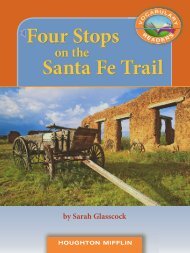Lesson 10:Saving the Mexican Wolves
Lesson 10:Saving the Mexican Wolves
Lesson 10:Saving the Mexican Wolves
- No tags were found...
You also want an ePaper? Increase the reach of your titles
YUMPU automatically turns print PDFs into web optimized ePapers that Google loves.
<strong>Mexican</strong> wolves live in family groups called packs. A packconsists of an adult pair (which usually mates for life), <strong>the</strong>irpups, and sometimes <strong>the</strong> pair’s older offspring. Each packhas its own territory, which can range from <strong>10</strong>0 to more than500 square miles. <strong>Wolves</strong> mark <strong>the</strong> boundaries of <strong>the</strong>ir territorywith scent to keep o<strong>the</strong>r wolf packs away.The members of a wolf pack communicate with each o<strong>the</strong>rby barking, growling, and whimpering, as well as with bodypostures and movements. Dogs use many of <strong>the</strong> same behaviorswhen <strong>the</strong>y try to communicate with people. The howling ofwolves is an eerie, mysterious sound. <strong>Wolves</strong> howl to locate oneano<strong>the</strong>r or as a means of ga<strong>the</strong>ring toge<strong>the</strong>r. Howling is oftenheard before a hunt. During a hunt, <strong>the</strong> pack works toge<strong>the</strong>r tolocate, chase down, and kill <strong>the</strong>ir prey.Like dogs, wolves express <strong>the</strong>mselves througha variety of body postures.4
















